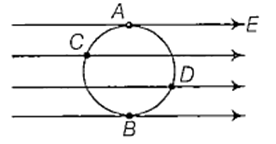 Multiple Choice Questions
Multiple Choice QuestionsIn the uniform electric field of E = 1 x 104 NC-1, an electron is accelerated from rest. The velocity of the electron when it has travelled a distance of 2 × 10-2 m is nearly
8.5 × 106 ms-1
1.6 × 106 ms-1
0.85 × 106 ms-1
0.425 × 106 ms-1
A.
8.5 × 106 ms-1
By work-energy theorem,
Work done by electric field = Change in KE of electron
Acceleration of a charged particle of charge q and mass m moving in a uniform electric field of strength E is
mqE
A small oil drop ofmass 10-6 kg is hanging in at rest between two plates separated by 1 mm having a potential difference of 500 V. The charge on the drop is (g = 10 ms-2)
2 × 10-9 C
2 × 10-11 C
2 × 10-6 C
2 × 10-9 C
A uniform electric field in the plane of the paper as shown. Here A, B, C and D are the ponits on the circle. V1, V2, V3 and V4 are the potentials at those points respectively. Then

VA = VC, VB = VD
VA = VC, VB > VD
VA > VC, VB > VD
VA = VB, VC > VD
Two metal spheres of radii 0.01 m and 0.02 m are given a charge of 15 mC and 45 mC respectively. They are then connected by a wire. The final charge on the first sphere is
40 × 10-3 C
30 × 10-3 C
20 × 10-3 C
10 × 10-3 C
If a charge on the body is 1 nC, then how many electrons are present on the body ?
1.6 × 1019
6.25 × 109
6.25 × 1027
6.25 × 1028
Two equal and opposite charges of masses m1 and m2 are accelerated in an uniform electric field through the same distance. What is the ratio of their accelerations if their ratio of masses is = 0.5 ?
What is the nature of Gaussian surface involved in Gauss's law of electrostatic ?
Scalar
Electrical
Magnetic
Vector
A spherical conductor of radius 2 cm is uniformly charged with 3 nC. What is the electric field at a distance of 3 cm from the centre of the sphere ?
3 × 106 Vm-1
3 Vm-1
3 × 104 Vm-1
3 × 10-4 Vm-1
The angle between the dipole moment and electric field at any point on the equatorial plane is
180°
0°
45°
90°
